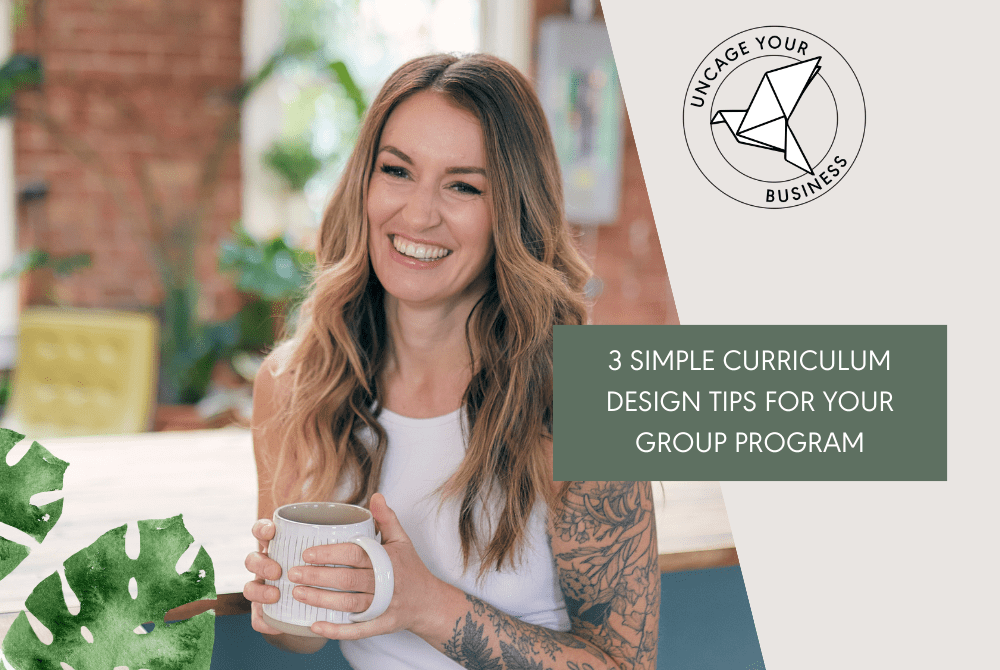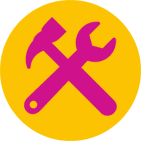
3 Simple Curriculum Design Tips For Your Group Program
One thing that really gets my goat in the online coaching industry is the relentless focus on LAUNCHING and SELLING (yes, both extremely important) — but with almost zero attention on creating a brilliant experience for the people going through your program!
Curriculum design is so important, because it’s the thing that gets your people the results they crave — and YOU the glowing testimonials from happy students.
Plus, it’s the thing that will determine whether your students actually FINISH your course and stay engaged the whole way through. Which is what you want. You don’t want to become just another program that someone joined and never completed.
Here’s the big secret: curriculum design (ie. creating a program structure that gets results) doesn’t have to be complicated. In fact, simple is better. So if you’re panicking at the thought of it, relax — I’m going to walk you through some super simple and actionable tips for your next (or first!) group program.
3 Group Program Curriculum Design Tips
If you’re wondering why I love group programs so much, what one even is, and whether you’re ready to run one, you can check out these handy blog posts to learn more.
What’s the best business model to scale with?
3 Major Differences Between Group And One-On-One Coaching
AND if you want your ticket to uncaged biz freedom, I go much deeper into creating, launching and running your first group program in my aptly named self-study course, Your First Group Program. Take a look here.
Ok, on with the curriculum design tips!
1. Don’t just lecture — help your students take ACTION
With a group program, your goal is to take people from conscious incompetence (they’re aware they have a problem) to conscious competence (they’re aware there’s a solution, and they’re actively working towards it).
If you want people singing the praises of your program, it’s very important to understand learning retention.
- Receiving: Via lectures, audio, reading — we retain 20% of the information
- Participating: Discussion, exercises, worksheets — we retain about 20 to 75%
- Doing: Action, practice, implementing — we retain 75%+
That’s a big range, right? And it shows the power of helping people take action rather than just sharing information.
You need to be careful not to pack your program with everything you know, or with too much theory. Remember, your goal isn’t to teach them to be an expert, or to learn everything that you know. Your goal is to help them have a transformation of some kind and get some kind of results.
The takeaway? Always include action, and not too much information.
2. Focus on how you’re moving students from A to B
Here’s the thing: when you’re working with one-on-one clients, it’s not always a linear process, right? They come in with a problem, you know they want to leave with the result, and you probably popcorn around pulling from your tools, working with them where they’re at.
When you have a group, you can’t do that. The process needs to be more linear because you can’t just show up and go, “What are we gonna talk about today?” You need to have a plan because there’s not the space for individual customization.
Here’s how to think about moving from point A to point B for your particular group program.
- Point A is the main problem that they’re coming in with.
- Point B is the main result that they’re going to leave with.
- You need to develop actions that will get them from A to B
- Then turn these actions into the homework for your program
I know it’s super tempting to want to over-deliver and include every single thing you know in your group program. It’s great to want to give people something better than what they thought they were gonna get.
But the way to do that is not by teaching them more and packing your program with more content, okay? It’s by helping them take action!
You literally teach them a snippet, you have them go out and do something (we learn best by doing!) and they have the transformation.
Example time!
- Say you’re a life coach your program is about how to stand up for yourself, set boundaries and stop people-pleasing.
- An action step for your people might be to go out and actually say no to three things this week, then journal on how they felt ahead of time, how it felt after and anything they would change next time.
- The transformation is happening already and with this homework, you can have your people feedback on the experience in the next call and have a really rich discussion.
THIS is how transformation happens. You want to make sure your curriculum focuses on easy steps or exercises for your students that they can do and learn from right away.
Remember, results happen when people take small, doable actions — NOT from learning more information.
Wanna learn how to create your own A+ curriculum so you can be sure your students get results? I walk you through this entire process in Your First Group Program!
3. Don’t pre-record ANYTHING
I know, I know – you want to look professional and might think you need to actually record your whole program before you run it. You don’t and shouldn’t!
GREAT curriculum comes from running your program, paying attention to what worked and what didn’t, adding examples. Tweaking homework, getting feedback, and making changes along the way.
If you spend a bunch of time (and money) pre-recording everything, you don’t have the ability to change it week to week based on how the group is going. Teaching/coaching LIVE will be your best bet when you’re first getting your program running.
You’re going to want and need that flexibility to move things around in your first few rounds. Let’s say you have planned X amount of content for week 1… but once you get into teaching live, people have a lot of questions, you end up in a rich discussion that is SUPER valuable for your students, and you only get halfway through the material…. then what? You have to shift all the content that comes after that, and all your pre-recordings are a waste. You may even develop new ideas for content after teaching/coaching on that first day, and you don’t want to be so rigidly stuck to your pre-recorded videos that you miss other incredible learning opportunities for your students.
Later, once you have proven your curriculum works by teaching it live a few times, and you have the results to show for it, you can record your content and make it more evergreen.
The model I teach in Your First Group Program is a LIVE coaching model, so while you might have pre-recorded content eventually, you will still be doing live coaching calls with your students (we teach you a few options for what schedule works best in Your First Group Program).
HOT TIP: If your goal is to create an online course/evergreen program, you should ABSOLUTELY start with teaching it live. The best courses come from having taught the material over and over and over again with real humans, and fine-tuning it along the way so that you fill any gaps in learning, add extra exercises/homework to make sure people get results, cut out sections that don’t help in students moving forward, and getting feedback each step of the way to make SURE that your course will “work” for people to get results. I strongly do not recommend trying to create a self-study style online program without first running it live at least a few times.
Ok, so these three tips should get you started with creating an epic group program that actually gets results!
If you take away one thing from this post, let it be this: Bite size content and taking more action is always going to be better. When people get those quick wins, they’re more likely to stay in the process and send you a glowing testimonial about how much you’ve changed their life! And nothing feels better than that.
Want to run a group program that becomes your signature offer and gets bigger and better every single time you run it? Of course you do! We go deeper into curriculum design, pricing, launching and list-building inside my self-study Your First Group Program.
Create your own group program and scale your business to 6 figures and beyond!
xx becca

